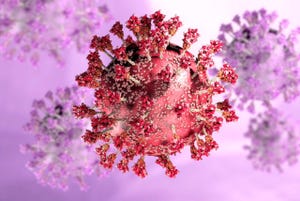Printed Eye Cells Thrive
January 14, 2014
|
Closeup of retinal cells in a jet. (Courtesy of Lorber et al) |
In research published as far back as 2005, scientists have been experimenting with using inkjet printer technology to deposit living cells for such applications as skin grafts. Now two types of retinal cells from adult rats have been successfully printed and grown in culture. In "Adult Rat Retinal Ganglion Cells and Glia Can Be Printed by Piezoelectric Inkjet Printing," Barbara Lorber, University of Cambridge, UK, et al., say that "printing of retinal ganglion cells and glia using a piezoelectric printhead does not adversely affect viability and survival/growth of the cells in culture."
This is significant because, in the words of Lorber and study co-author Keith R. Martin, also of the University of Cambridge, "Our study has shown, for the first time, that cells derived from the mature central nervous system, the eye, can be printed using a piezoelectric inkjet printer." Although embryonic neuronal cells have been successfully deposited using inkjet technology before, this is the first time mature neurons have been printed. "Adult neuronal cells are really quite fragile," says Martin. "We were actually quite surprised at how well these adult neuronal cells survived the printing process."
The group observed "no evidence of destruction or even significant distortion of the cells during jet ejection and drop formation. Importantly, the viability of the cells was not affected by the printing process," the paper's abstract states.
In a release posted on the University of Cambridge Web site, Martin says, "We plan to extend this study to print other cells of the retina and to investigate if light-sensitive photoreceptors can be successfully printed using inkjet technology. In addition, we would like to further develop our printing process to be suitable for commercial, multi-nozzle print heads."
Learn more about 3-D printing in a series of conference sessions at MD&M West in Anaheim, CA. |
This work might one day lead to new retinas being grown outside the eye and then implanted, or possibly even deposited right into the patient's eye during surgery. Before any of this could happen, however, other types of cells such as photoreceptors and retinal pigment epithelial cells must be successfully deposited, and the whole structure built, then interconnected and hooked up as it naturally grows. Then this freshly built retina must be interfaced with the patient's optic nerve. It might be a little early to book a reservation, in other words.
About the Author(s)
You May Also Like



